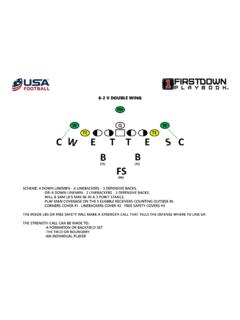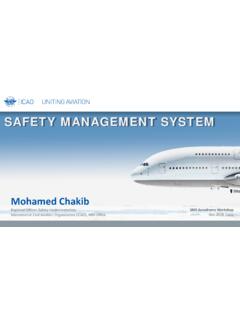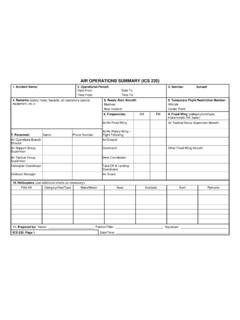Transcription of SAFO21007, Risk of Potential Adverse Effects on Radio ...
1 SAFO. safety Alert for Operators SAFO 21007. Department DATE: 12/23/21. of Transportation Federal Aviation Flight Standards Service Administration Washington, DC. A SAFO contains important safety information and may include recommended action. Besides the specific action recommended in a SAFO, an alternative action may be as effective in addressing the safety issue named in the SAFO. The contents of this document do not have the force and effect of law and are not meant to bind the public in any way. This document is intended only to provide clarity to the public regarding existing requirements under the law or agency policies. Subject: Risk of Potential Adverse Effects on Radio Altimeters when Operating in the Presence of 5G C- Band Interference. Purpose: This SAFO provides information and guidance to operators regarding the risk of Potential Adverse Effects on Radio altimeters when operating in the presence of 5G C-Band wireless broadband signals, and the role of Notice to Air Missions (NOTAMs) in identifying the geographic areas where certain operations requiring a Radio altimeter are prohibited in the presence of 5G signals (in the C-Band).
2 By Airworthiness Directives (ADs) 2021-23-12 and 2021-23-13. Background: The Federal Aviation Administration (FAA) adopted new ADs (AD 2021-23-12 and AD. 2021-23-13) for all transport and commuter category airplanes, and all helicopters, equipped with a Radio altimeter. The Radio altimeter is an important aircraft instrument, and its intended function is to provide direct height-above-terrain/water information to a variety of aircraft systems 1. Commercial aviation Radio altimeters operate in the GHz band, which is separated by 220 megahertz from the C-Band telecommunication systems in the GHz band. 2 These ADs were prompted by a determination that Radio altimeters cannot be relied upon to perform their intended function if they experience interference. The ADs require revisions to the limitations section of the existing aircraft/airplane flight manual or rotorcraft flight manual, as applicable, to incorporate limitations prohibiting certain operations requiring Radio altimeter data when in the presence of 5G C-Band interference in areas and at airports identified by NOTAMs.
3 The FAA issued these ADs to address the unsafe condition on these products. The Radio altimeter is more precise than a barometric altimeter and for that reason is used where aircraft height over the ground needs to be precisely measured, such as during autoland or other low altitude operations. The receiver on the Radio altimeter is typically highly accurate, however it may deliver erroneous results in the presence of out-of-band radiofrequency emissions from other frequency bands. The Radio altimeter must detect faint signals reflected off the ground to measure altitude, in a manner similar to radar. Out-of-band signals could significantly degrade Radio altimeter functions if the altimeter is unable to sufficiently reject those signals. 1. Radio altimeters are also known as radar altimeters or RADALT. 2. The FAA expects deployment to commence January 5, 2022. Distributed by: Air Transportation Division While the FAA issued ADs 2021-23-12 and 2021-23-13 to address operations immediately at risk ( , those requiring a Radio altimeter to land in low visibility conditions), a wide range of other automated safety systems rely on Radio altimeter data whose proper function may also be affected.
4 Anomalous (missing or erroneous) Radio altimeter inputs could cause these other systems to operate in an unexpected way during any phase of flight - most critically during takeoff, approach, and landing phases. These anomalous inputs may not be detected by the pilot in time to maintain continued safe flight and landing. Operators and pilots should be aware of aircraft systems that integrate the Radio altimeter, and should follow all Standard Operating Procedures related to aircraft safety system aural warnings/alerts. These systems include, but are not limited to: Class A Terrain Awareness Warning Systems (TAWS-A). Enhanced Ground Proximity Warning Systems (EGPWS). Traffic Alert and Collision Avoidance Systems (TCAS II). Take-off guidance systems Flight Control (control surface). Tail strike prevention systems Windshear detection systems Envelope Protection Systems Altitude safety call outs/alerts Autothrottle Thrust reversers Flight Director Primary Flight Display of height above ground Alert/warning or alert/warning inhibit Stick pusher / stick shaker Engine and wing anti-ice systems Automatic Flight Guidance and Control Systems (AFGCS).
5 Discussion: Initial deployment of 5G wireless broadband networks in the C-Band is expected to begin on January 5, 2022 and be limited to 46 predetermined areas known as Partial Economic Areas (PEAs), 3 The FAA will issue NOTAMs to identify the areas, airports and heliports where the Radio altimeter is unreliable due to the presence of 5G C-Band interference. The NOTAMs will also note exceptions for operators holding an FAA-approved alternative method of compliance (AMOC) with the applicable AD. 4. To address the prohibitions in the two ADs, the FAA will use four types of NOTAMs to identify the areas, airports and heliports where the Radio altimeter is unreliable. Operators should be aware that additional aircraft systems integrated with the Radio altimeter might not function normally in areas identified by such NOTAMs, due to the presence of 5G C-Band interference. The following describes the types of the NOTAMs the FAA expects to issue: 3. Subsequent implementation phases can be expected after December 5, 2023.
6 4. Please see paragraph (h) of AD 2021-23-12 and AD 2021-23-13 for information specific to the ADs, and FAA Advisory Circular 39-10 for general information regarding AMOCs. Distributed by: Air Transportation Division Airspace: An airspace NOTAM will delineate a three-dimensional area where the Radio altimeter is unreliable due to the presence of 5G C-Band wireless broadband interference. Operations identified by AD 2021-23-13 are prohibited in this airspace, unless the operator has an FAA-approved AMOC. Example Airspace NOTAM: ZHU AIRSPACE RDO ALTIMETER UNREL WI AN AREA DEFINED AS XXXNM RADIUS OF. XXXXXXNXXXXXXXW (VOR/DME) SFC-5000FT AGL. HEL OPS REQUIRING RDO. ALTIMETER DATA FOR OFFSHORE INSTRUMENT OPS, HOVER AUTOPILOT MODES, SAR. AUTOPILOT MODES, AND CAT A/B/PERFORMANCE CLASS TKOF AND LDG NOT. AUTHORIZED EXC FOR ACFT USING APPROVED ALTERNATIVE METHODS OF. COMPLIANCE DUE TO 5G C-BAND INTERFERENCE PLUS SEE AIRWORTHINESS. DIRECTIVE 2021-23-13. Aerodrome: An aerodrome NOTAM will identify any public airport or heliport (with an instrument approach procedure) where the Radio altimeter is unreliable due to the presence of 5G C-Band wireless broadband interference, and the operations at that airport or heliport that are prohibited by the ADs, unless the operator has an FAA-approved AMOC.
7 Example Aerodrome NOTAM for airports: BDL AD AP RDO ALTIMETER UNREL. AUTOLAND, HUD TO TOUCHDOWN, ENHANCED. FLT VISION SYSTEMS TO TOUCHDOWN NOT AUTHORIZED EXC FOR ACFT USING. APPROVED ALTERNATIVE METHODS OF COMPLIANCE DUE TO 5G C-BAND. INTERFERENCE PLUS SEE AIRWORTHINESS DIRECTIVE 2021-23-12. Instrument Approach Procedure (IAP): An IAP NOTAM will identify the public and special IAPs affected by 5G C-Band interference, and prohibited by the ADs unless the operator has an FAA-approved AMOC. Example IAP NOTAM against impacted approaches (SA CAT I / II, CAT II, III, or RNP AR): BDL IAP BRADLEY INTL, WINDSOR LOCKS, CT. ILS RWY 06 (SA CAT I AND SA CAT II), AMDT 13A ILS RWY 06 (CAT II AND CAT III), AMDT 38A RNAV (RNP) Z RWY 06, AMDT 1 RNAV (RNP) Z RWY 24, AMDT 1 PROCEDURE NOT AUTHORIZED EXC FOR. ACFT USING APPROVED ALTERNATIVE METHODS OF COMPLIANCE DUE TO 5G C- BAND INTERFERENCE PLUS SEE AIRWORTHINESS DIRECTIVE 2021-23-12. Special IAP: A special IAP NOTAM will identify an IAP (except SA CAT I / II, CAT II, III, or RNP.)
8 AR), at a private landing location, affected by 5G C-Band wireless broadband interference, and the operations prohibited by the ADs unless the operator has an FAA-approved AMOC. Example Special IAP NOTAM for airplanes: SPECIAL COOK CANYON RANCH, RANGER, TX. RNAV (GPS) RWY 17, ALTIMETER UNREL. AUTOLAND, HUD TO TOUCHDOWN, ENHANCED FLT VISION. SYSTEMS TO TOUCHDOWN NOT AUTHORIZED EXC FOR ACFT USING APPROVED. ALTERNATIVE METHODS OF COMPLIANCE DUE TO 5G C-BAND INTERFERENCE PLUS. SEE AIRWORTHINESS DIRECTIVE 2021-23-12. Distributed by: Air Transportation Division Recommended Action: 1. Domestic and foreign operators and pilots should be familiar with the content of this SAFO, ADs 2021-23-12 and 2021-23-13, and Special Airworthiness Information Bulletin (SAIB) AIR-21-18. The FAA notes that SAIB AIR-21-18, which recommended reporting actions if Radio altimeter anomalies occur, has been updated, effective December 23, 2021. 2. Domestic and foreign operators and pilots should evaluate the Effects of the 5G C-Band NOTAMs on their flight activities and locations.
9 3. Domestic and foreign operators and pilots should review the aircraft systems that integrate the Radio altimeter. They should be aware of the Potential degradation of the Radio altimeter capabilities, the Potential degradation to the capabilities of safety systems and other equipment dependent upon Radio altimeter data, and any means to compensate for in-flight Radio altimeter anomalies for their specific aircraft. Contact: Direct questions or comments regarding this SAFO to the Flight Technologies and Procedures Division, Flight Operations Group at (202) 267-8790 or e-mail: for operational issues. Distributed by: Air Transportation Divisio















